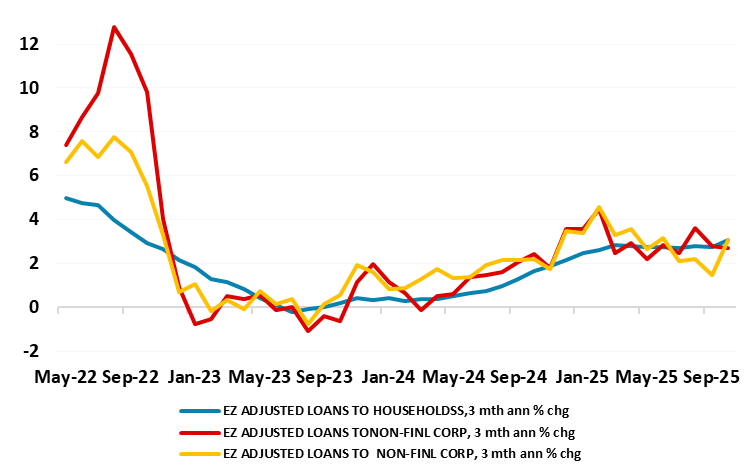ECB: Financial Stability Review Less Complacent than Council?
The ECB is clearly split about whether policy has troughed or not, this mainly a result of differences within the Council as to where inflation risks lie. Regardless, as the account of the Oct 29-30 Council meeting chimed with comments from the meeting’s press conference, it does seem to us as if at least some of the ECB may be overlooking a backdrop where the monetary transmission mechanism is not running as smoothly as it alleges. Indeed, even in nominal terms private sector credit growth has slowed (Figure 1). Moreover, this has occurred amid fresh signs of banking sector wariness that may be a sign that global risks have materialised rather than dissipated. Notably, the just released ECB Financial Stability Review (FSR) offers perhaps a less complacent picture, actually explaining why bank lending may have slowed of late.
Figure 1: EZ Private Sector Credit Slowing

Source: ECB
The ECB Council is of the view that downside growth risks have dissipated somewhat, this possibly helped by its recent actions which it suggests leave its current policy stance in a good place. However, amid a hint of what we think is a complacent upgrade about the EZ’s alleged resilience, we think, the ECB may be overlooking a backdrop where the monetary transmission mechanism is not running as smoothly as it maintains. We have highlighted several symptoms of a monetary policy transmission mechanism that, rather than functioning smoothly and effectively, is doing the very opposite and maybe increasingly so. These include survey evidence suggesting banks being increasingly willing to reject loan applications completely (especial for consumers) rather than just attach stricter credit standard criteria – this finding from the bank lending survey was completely overlooked by the last ECB meeting.
But perhaps the greatest indictment of monetary transmission mechanism alleged to be working effectively is the simple fact that actual lending rates to household and companies have failed to match the reduction in official rates – very much so as far as households are concerned. Indeed, with official easing worth some 200 bp, albeit this having shrunk somewhat in terms of how market rates have fared of late, it is worth noting that company lending rates have fallen some 25 bp less. But for households, actual effective lending rates have fallen just some 75 bp and have been stable to rising since the beginning of the year, despite the ECB cuts since that juncture. This is hardly normal, satisfactory let alone effective monetary transmission
While the ECB Council may be complacent about such developments, the Financial Stability arm of the central bank seems more perturbed, certainty about risks. Admittedly, it is the job of the Financial Stability to highlight risks. Buy what we think is pertinent at present is that the risks and developments its highlighted in its just released biannual FSR help explain what is a very clear slowing in private sector credit (as highlighted by monthly data released earlier today).
In particular, the fresh increase in consumer loan rejections and the very modest drop in effective lending rates to the household sector can be seen in a perspective where consumer lending has shown signs of a mild deterioration in asset quality in recent quarters. According to the FSR, this is evidenced by a gradual, albeit contained, rise in aggregate Non-Performing loan ratios for consumer loans since late 2023. By borrower location, the composition of consumer loan NPLs has shifted slightly towards euro area exposures since late 2023. The concern voiced by the FSR is that while aggregate unemployment remains low, these developments, along with the recent slowdown of real wage growth, suggest that a subset of consumers with lower incomes could become financially constrained. This is particularly the case if economic conditions were to weaken more than currently expected, possibly leading to a further deterioration of asset quality in this loan portfolio. This suggest that signs of weaker consumer credit growth may be more supply orientated than demand.
But the more discernible slowing in corporate credit growth may be more demand determined. The FSR notes that EZ corporates continue to face elevated debt servicing costs. While the recent cuts in interest rates have reduced costs for new corporate borrowing, the stock of outstanding debt is continuing to reprice at less favourable conditions, keeping debt service ratios elevated. Survey data show that most firms believe their financial positions are under strain from weaker external demand, which is squeezing their profitability. All of which suggests that such fresh signs of banking sector wariness that may be a sign that global risks have materialised rather than dissipated.